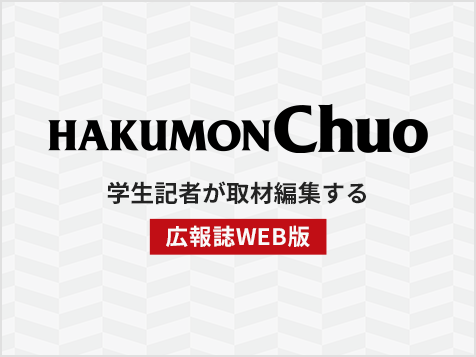人文科学研究所
国際シンポジウム/International Symposium
声と文字とをデザインする ――コミュニケーション帝国としてのモンゴル ――
“Designing Voices and Letters: The Mongols as an Empire of Communication”
開催概要/General Info
【日程/Date】
2018年7月1日(日)~2日(月)
1st and 2nd, July 2018
【場所/Venue】
中央大学駿河台記念館570号室
Room 570 Chuo University Surugadai Memorial Hall
【使用言語/Language】
英語
English
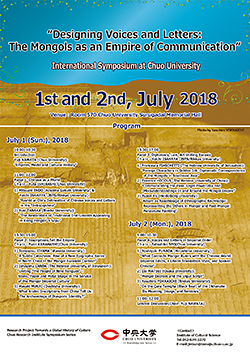
印刷用ポスターはこちら(2.2MB)
開催報告/Report
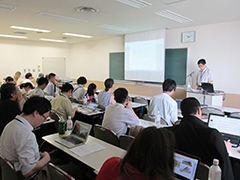
Introduction
研究代表者 縄田雄二 文学部教授
2日間にわたって行われたこのシンポジウムでは、まずは研究代表者の縄田が、自身が専門とするドイツ語圏の「文化学/文化史(Kulturwissenschaft)」が文化要素のみならず、それを媒介するモノにも着目し、研究を深化させてきたこと、そしてその射程をヨーロッパを超えて拓いていくことの可能性に言及した。それは「グローバル文化史の試み」の1つであり、このプロジェクトの最初のシンポジウムが、広くアフロ・ユーラシアを域圏としたモンゴル帝国(1206~1368年)について扱う理由の1つでもあった。その後に個々の報告が続く。
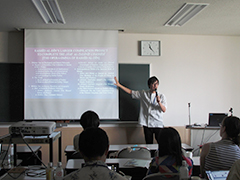
Panel 1
諫早庸一 客員研究員
(日本学術振興会 立教大学 特別研究員)
まずは第1パネル “Chinese as a World” において、イル・ハン朝(1256年頃~1357年頃)の宮廷における漢字音の正確な再構を伴う翻訳運動と、元朝期(1271~1368年)の古楽器の再現の試みおよびその意味が論じられた。第2パネル “Inscriptions Tell the Empire” では華北のモンゴル支配が在地の石刻文化に影響して生まれた新たな碑文スタイルや、石・紙・鉄を通じた多様なモンゴル帝国のコミュニケーション文化、および故地を遠く離れた中国沿岸部のムスリム・ディアスポラに彫られたアラビア語碑文など、記すことまたは記されたものについての考察が主体となった。次の第3パネル “Diplomacy, Law, Art Uniting Eurasia” においては、外交・法律・美術それぞれの分野において、異なる文化や階層の人・モノ・情報がどのように通じ合っていたかについて議論が深められた。第4パネル “Voices and Letters in Imperial Order” では、モンゴル語直訳体やウイグル文字、印章といった個々の媒介物/手段を通じて、モンゴル帝国のコミュニケーション手段の一端およびその展開が明らかにされた。
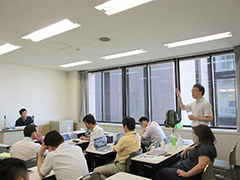
General Discussionの様子
最後の総括においては縄田が、このシンポで議論された内容を以下の3つの動名詞で表現した。それが、1) Circulating, 2) Remembering, 3) Assembling である。空間に関わる1)に対して、2)は時間に関わるものであり、3)は例えばイル・ハン朝において編纂された『集史』に象徴されるような空間・時間をわたるコミュニケーションによって積み重ねられたものである。このまとめを皮切りに討論は、例えば時代に関して、同様に広域を支配したローマ帝国や活版印刷普及以後の世界との比較に話が及んだ。空間に関しては、モンゴル帝国のコミュニケーションが、帝国の様々な局面で利用されていた馬やその文化にどれだけ規定されていたのかという議論もなされた。集合に関しては史書だけではなく、系譜もそうであるとの意見も。空前の領域を支配し、新たな文字や文体や認証システムを生み出したモンゴル帝国であったが、実のところコミュニケーション体系にしても、それ以前からの伝統を踏まえたものが多く、それらをベースに種々の変化を加えた “Changes in Continuity” とも言える部分が大いにあるという意見もあった。このように、テーマと同じく、広がりのある議論が展開された。
In the opening remarks of this two-day symposium, Nawata—the principal investigator of the research project “Towards a Global History of Culture”—mentioned the significance of this symposium in the context of Kulturwissenschaft, which has deepened our understanding of “culture” by focusing not only on cultural elements themselves but also on media between culture(s). This symposium aimed at broadening the scope of this approach by going beyond the West, with which Kulturwissenschaft has mostly been concerned. With this purpose, we concentrated especially on the Mongol empire (1206–1368), which influenced Afro-Eurasia broadly.
In the first panel, “Chinese as a World,” we discussed 1) a Chinese-into-Persian translation project during the Ilkhanid dynasty (ca. 1256–1357), with precise reconstruction of the sounds of Chinese then; and 2) the restoration of a Chinese traditional musical instrument and its significance under the Yuan dynasty (1271–1368). The second panel, “Inscriptions Tell the Empire,” revolved around the act of writing and what was written, by focusing on 1) a new genre of tomb inscriptions under the influence of Mongol rule in Northern China; 2) various materials of communication media like stone, paper and iron; and 3) Arabic epitaphs in Muslim diasporas in the Chinese coastal areas far from the native lands. In the third panel, “Diplomacy, Law, Art Uniting Eurasia,” we dealt with actual phases of the communication of peoples, material, and information between cultures and classes in the fields of 1) diplomacy, 2) law, and 3) the arts. The fourth panel, “Voices and Letters in Imperial Order,” elucidated some important communication media and their development by discussing 1) the Mongol-imperial “literal translation style,” 2) Uyghur script, and 3) seals.
In the general discussion, Nawata outlined the topics and discussions of this symposium with the following three words: 1) circulating, 2) remembering, and 3) assembling. While the first word was related to space, the second was about time. The third term, on the other hand, refers to something accumulated through communication across time and space, as for example the Jāmiʿ al-Tawārīkh [Collected Histories]—a compendium of histories of the world compiled in the Ilkhanid dynasty. On the basis of these terms, the discussion concerning time extended to comparison with other eras such as the “Pax Romana” and the age of printing. Regarding space, we also considered the influence of horses and nomadic culture in the communication system of the empire. We also affirmed that not only chronology but also genealogy exemplified “assembling” in the imperial culture. While the Mongols created the largest landmass empire in history and utilized a new script and writing style, quite a few of their communication systems were in fact based on existing communication cultures. In this sense, their designs of voices and letters could be said to be “changes in continuity.”
概要/Description
このシンポジウム「声と文字とをデザインする ――コミュニケーション帝国としてのモンゴル ――」は、政治権力とコミュニケーション体系との複雑な関係について議論する場であり、その焦点をモンゴル帝国(1206~1368年)に定めている。この種の関係の歴史的展開は、例えばハロルド・イニスの代表作『帝国とコミュニケーション』などによって、すでに詳細に研究されている。しかしイニスの叙述は、古代から中世を経て近代に至る「西洋」の発展を叙述しながら、必要に応じて「その他」に言及するというヘーゲル的な古典史観を超えてはいない。このシンポジウムは、イニスの後は例えばフリードリヒ・キットラーへと受け継がれたこの長きに亘る議論の「脱西洋中心主義化」を図ることで、この問題に新たな光を当てようとするものである。「西洋」と「その他」とを包括し、コミュニケーション体系においても際立った多様性を見せていたモンゴル帝国は、その格好の題材となる。
Our symposium “Designing Voices and Letters: The Mongols as an Empire of Communication” aims to provide an appropriate platform to discuss about entangled relationship between political powers and communication media, by especially dealing with the case of the Mongol empire (1206–1368). The historical strand of such relationship was already detailed, for example, by Harold Innis in his chef-d’œuvre Empire and Communications. However, he was based on what might be called “Hegelian historical narrative” which traced the development of the “West”—from the antiquity to the modern eras via the medieval ages—with referring to the “others” pro re nata. At the workshop, therefore, we attempt to shed some new light upon this long-discussed issue, which has been addressed after Innis by for example Friedrich Kittler, through emancipation from “Eurocentric” history. This perspective turns our attention toward the Mongol empire which encompassed the “West” and the “others,” standing out with the full variety of communication.
プログラム/Program
| July 2 (Mon.), 2018 | |
|---|---|
| 9:00–10:30 | Panel 4: Voices and Letters in Imperial Order Chair: Tatsuhiko SEO(Chuo University) |
|
1) Yoshiyuki FUNADA (Hiroshima University): |
|
|
2) Dai MATSUI (Osaka University): |
|
|
3) Yasuhiro YOKKAICHI (Rikkyo University): |
|
| 11:00–12:00 | General Discussion (Chair: Yuji NAWATA) |
主催/Sponsored by
中央大学学術シンポジウム「グローバル文化史の試み」
Research Project Towards a Global History of Culture Chuo Research Institute Symposium Series
